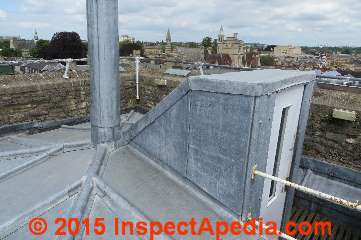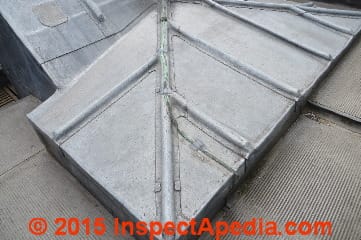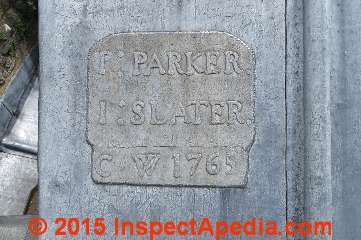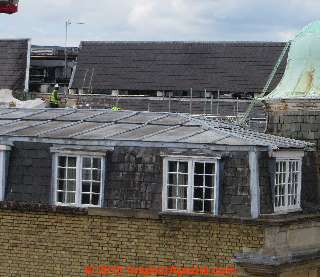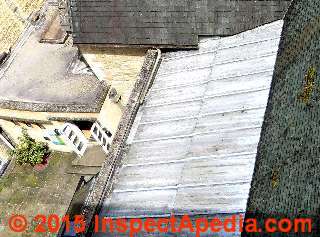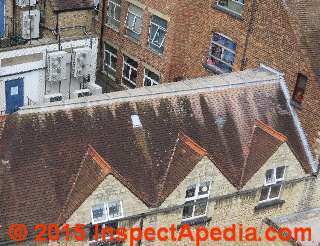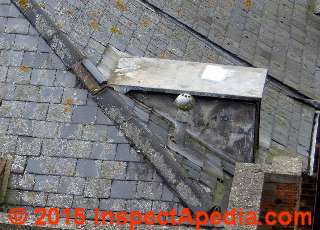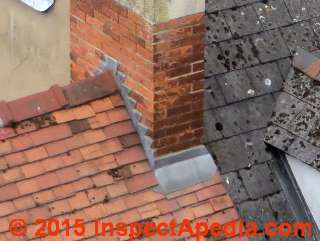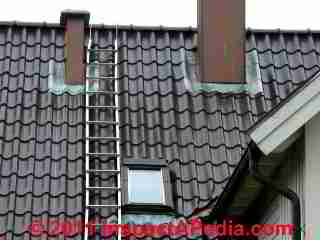 Lead Roofing Metal Uses & Effects
Lead Roofing Metal Uses & Effects
- POST a QUESTION or COMMENT about lead roofing materials & lead flashing
Lead roofing covers, flashings, materials guide:
This article describes and illustrates the use of lead on roofs both as the primary roof covering material and as roof flashings. We include photographs from several countries illustrating the durability of lead roofs. The article series also discusses the health & environmental effects of using lead roofing products and metals.
Shown at page top: lead flashing around chimneys and below a skylight on a fired-clay tile roof in Oslo, Norway. The flexibility of lead makes it an ideal flashing material when the flashing must adapt to curved or irregular surfaces such as the tile roof shown here.
InspectAPedia tolerates no conflicts of interest. We have no relationship with advertisers, products, or services discussed at this website.
- Daniel Friedman, Publisher/Editor/Author - See WHO ARE WE?
Effects of Lead in Roofing Systems
Shown above and below we see lead roofing atop the Saxon Tower at St. Michaels in Oxford, England in the U.K. Nearly a thousand years old, this is the oldest building in Oxford, dating from at least 1040 A.D., about the time of the Norman Conquest or shortly afterwards. Portions of the tower roof and access stair top are roofed in lead sheeting.
This tower probably served in defence of the north gate of the city of Oxford. The lead roof shown is, of course not quite so old. Its installers Parker and Slater dated their work with the placque shown below: 1765, making this lead roof over 200 years old.
[Click to enlarge any image]
Shown above is a closer view of how this lead roof is assembled. The lead panel edges are folded upwards, abutted together, and the raised seam is covered by the caps that you see as rounded ridges.
Soldered tabs hold the seam cap in place whiile allowing thermal movement among panels without buckling the roof. By the time this roof was installed, lead roofers had perhaps 800 years of experience. Well ... not individually.
We continue with additional examples of lead used in roofing.
Lead Panels Used on Steep Roofs
The steep tower roof shown above, also located in Oxford, is sheathed in lead panels with raised seams.
This lead panel and raised seam approach is quite similar to the Parker/Slater lead use atop the Saxon tower. The seams are lead-soldered. The lead roof panel size was doubtless chosen for ease of working.
Lead Used on Flat & Low-Slope Roofs
Shown above, another Oxford lead roof, larger lead panels cover a low-pitched roof. These larger panels also use the folded, capped standing seam approach to permit movement and avoid leaks in the roof. Shown below is a second low-slope, large lead-panel-covered Oxford roof that is viewed from the top of the Saxon tower - a great place to stand for studying British roofs. Click to enlarge the image and you might also notice the lead-lined eaves-trough gutter at the lower end of this roof.
One of my favourite lead roof photos is this tile roof, also in Oxford and also viewed from the Saxon tower. The roofers have used lead to seal the flat ridge area of a tile roof, lead to provide step flashing and counter flashing against an abutting building masonry wall, and lead flashing also around a small skylight set into the tile roof.
Compelling evidence that lead salts washing down off of the roof, like copper salts in our copper roof photos, manages to dissuade algae, lichens, and fungal growth on the roof tiles themselves. Notice that where more metallic salt run-down is produced by the wider lead roof area a corresponding greater area of light coloured (clean) roof tiles are in view.
Lead Used on Roof Dormers
Above the nearly-flat roof dormer has been covered with a single lead panel that extends up under slates and wraps around the side of the dormer roof sheathing.
Click to enlarge this photo for some other interesting details including lead flashing poorly installed around a plumbing vent - it laps only under the slates above the vent not under the slates at its side; the roofer who installed the dormer flashing took the same "put it on top" approach when flashing the dormer sides to the slate roof.
This detail is characteristic on older buildings into which plumbing was added later: nobody wants to have to pull off and re-install slates to get that plumbing vent in place.
An interesting additional vent, probably for a bathroom exhaust fan, is visible along the hip of this roof.
Lead Used as Roof Flashings
Here lead was used for a beautiful chimney flashing job in Oxford; notice that the step flashing, mostly not visible, is under the roof tiles, the counter flashing seals the tops of the step flashing agasint the chimney, and the bottom of the chimney flashing at its down roof side brings water out to daylight. I'm not so sure about the barely-in-view dormer side flashing in the right of this photo: perhaps that was a different roofer.
Note: we don't know if any the more recent lead flashings shown in this article series are traditional pure lead or newer (and safer) terne-coated metal designed to resemble lead. - Ed.
Lead Coated Copper and Health Effects:
... modern terne-coated stainless steel or lead-coated copper might produce a more durable yet visually compatible replacement roofing. [2]
"Lead Coated Copper Metal (LCC): A Case Study of Public Health Addressing Regulatory Gaps", Thomas Plant, MS, Leon Bethune, MPH, John Shea, MS, Paul A. Shoemaker, MPH, Jose R. Diaz, John W. Weathers, and Charles Mba, MS. Environmental Health Office, Boston Public Health Commission, 1010 Massachusetts Ave, 2nd floor, Boston, MA 02118, 617-534-2644, tplant@bphc.org 2007 Abstract:
Lead coated copper (LCC) has become popular as a stain free replacement for copper in large renovation and new construction projects. The Boston Public Health Commission investigated the home of a child with an elevated blood lead level (EBLL) of 11ug/dl. LCC was used on the roof, flashing, and a wall around the ground floor patio.
The condominium interior was free of lead hazards. Sampling found lead dust levels of 224,377 mgs/ft2 wiped from the wall, 36, 441 mg/ft2 on patio, 79,400 mgs/ft2 under the roof drip line, and 11,517 mgs/ft2 at a roof drain to the patio indicating that the LCC was the probable source of the EBLL. Roof areas receiving runoff from the LCC had high lead levels while others had low levels.
This presented a unique problem because LCC is not paint and thus not addressed by the Massachusetts Lead Law.
Using the Massachusetts Public Health Nuisance Laws, an Abatement Order was issued to remove the LCC, but stayed for six months pending study by all parties. The LCC wall was removed, but roof runoff still contaminated the patio and building perimeter.
An encapsulant paint is being investigated to abate lead hazards by covering the LCC roofing. A survey found widespread use of LCC in Boston buildings including hospitals, universities, daycare centers, libraries, office buildings, hotels, and residences.
A Public Health Advisory was issued, the manufacturer removed LCC from the market, and city policy was developed to restrict the use of LCC on city-owned buildings.
Several queries about the effects of lead in roofing systems led us to find this 2002 Q&A offered by NRCA's Jack Robinson, RRC., Quoting:
Question: What are the advantages of using lead or lead-coated copper when installing standing-seam metal roof systems? Are there any government regulations that prohibit or limit the use of lead or lead-coated copper in roof systems? Also, will water that runs off a roof system made from either of these materials pollute groundwater?
Answer: Lead is a soft, common metal with several properties that are useful in roofing applications. Lead-coated copper is copper sheeting coated with lead on one or both sides.
Because lead is malleable, it easily is shaped at relatively low temperatures (70 F [21 C]) without the need for periodic annealing to soften the lead and make it workable. Lead sheets can be manipulated readily with hand tools and formed into complicated shapes. When used for flashings, lead sheets can be formed and adjusted easily in the field to accommodate substrate irregularities.
Lead also is corrosion-resistant. When left exposed, it develops a silver-gray patina that is insoluble in water. Because of the patina's insolubility, rainwater runoff over a weathered lead surface carries little lead or lead-based chemicals. Water runoff from lead surfaces will not cause stains to be deposited on adjacent building materials, such as stone, masonry or cladding.
Lead-coated copper has several advantages when used to form metal roof systems. It provides a durable finish that can be left exposed or painted, and lead coating is more compatible with paint than other metals. Lead-coated copper also is lighter than lead sheets, which reduces roof panels' weight contribution to a roof assembly's dead load. Lead-coated copper, unlike copper, won't stain adjacent materials. It also is easier to form than plain copper because the lead coating acts as a lubricant.
Both lead and lead-coated copper are durable roofing materials with longer estimated service lives than other common steep-slope roof coverings.
In recent years, publicity regarding the toxicity of lead-based paint has been widespread. Many people incorrectly have assumed any exposed lead is a potential health hazard or pollutant.
As previously stated, exposed lead sheets and lead-coated copper are not significantly soluble in water. The same property that prevents lead from depositing stains on adjacent materials also prevents lead or lead-based compounds from being washed off a roof system's surface and carried into groundwater.
Some manufacturers of lead roof coverings have attempted to respond to the public's concerns by providing calculations of lead contamination for specific projects. These calculations take into account a roof system area that will contribute to watershed, estimated average amount of rainfall at a project's location and lead's corrosion rate.
Several of these calculations indicate that the contribution of lead to groundwater attributable to water runoff from a lead roof system is one to two parts per trillion. The level at which the Environmental Protection Agency (EPA) imposes restrictions for lead in drinking water is 15 parts per billion (approximately 15,000 times less than the amount of lead contamination attributable to water runoff from a lead roof system).
According to EPA representatives, there are no regulations that restrict or prohibit the use of lead or lead-coated copper in roof systems. However, should a question arise about a specific project, contact your regional EPA office for additional information. A list of EPA's 10 regional offices can be obtained from EPA's Web site, www.epa.gov.
Additionally, some states may have regulations governing lead usage. To determine whether your state has specific requirements that regulate or prohibit the use of lead or lead-coated copper roof systems, contact your state's environmental protection agency.
Lead Roofing & Flashing Hazard Research
- You should be aware there is an Occupational Safety and Health Administration (OSHA) standard that applies to those who work with lead—"The OSHA Guide to Occupational Standard for Lead (General Industry)." For information about this standard, contact Ken Brown, NRCA's director of risk management, at (847) 299-9070, Ext. 262.Web search 09/29/2010, - original source:
www.great-lakes.net/lists/p2tech/2003-08/msg00016.html - Peter McCafferty, "Suggested Procedure to Remove Lead Contamination from Roofs." [PDF] McCafferty, P, Chief Chemist, Natural Resources Chemistry Laboratory, Public Health, Australia, Western., retrieved 2015/12/03, original source http://www.public.health.wa.gov.au/cproot/1930/2/ Esperance%20CCWA%20Procedure%20to%20remove%20lead%20from%20roofs%20-%20LH.pdf
- Magnuson, Harold J., and B. O. Raulston. "Lead Poisoning in Roofers." Journal of the American Medical Association 114, no. 16 (1940): 1528-1530.
Abstract excerpt (incomplete):
During the last six months eight instances of lead poisoning in roofers have been encountered at the Los Angeles County General Hospital. Since a search of the literature fails to reveal an account of such a condition in this occupational group, and since in the light of our investigations the hazard of lead poisoning is a new one in these workers, a report is considered justified. The most important information concerning these patients is summarized in the accompanying table.
All the patients are males and with but two exceptions are in early adult life. These men have been working as roofers from periods of three months to ten years. All of them give a history of holding the galvanized roofing nails in their mouths while working. None of these give a history of any other exposure to lead. The most striking facts about the entire group are found in the ... - Magyar, M. I., A. R. Ladson, C. Diaper, and V. G. Mitchell. "Influence of roofing materials and lead flashing on rainwater tank contamination by metals." Australian Journal of Water Resources 18, no. 1 (2014): 71.
- Mao, J. S., Jing Cao, and T. E. Graedel. "Losses to the environment from the multilevel cycle of anthropogenic lead." Environmental Pollution 157, no. 10 (2009): 2670-2677.
- Plant, Thomas, Leon Bethune, John Shea, Paul A. Shoemaker, Jose R. Diaz, John W. Weathers, and Charles Mba. "Lead Coated Copper Metal (LCC): A Case Study of Public Health Addressing Regulatory Gaps." In Annual Meeting. 2007.
- Quek, Udo, and Jürgen Förster. "Trace metals in roof runoff." Water, Air, and Soil Pollution 68, no. 3-4 (1993): 373-389.
Abstract:
In this paper we present the concentration of heavy metals (Cd, Cu, Pb, Zn) in runoff from five different roofs (tar felt, pantiles, asbestos cement, Zn sheet, gravel) during two rainfall events. The heavy metal load of roof runoff is assessed and the different processes influencing the fate of heavy metals on roof surfaces and in roof runoff are discussed. The extent of contamination with heavy metals of runoff from different roofing material has the following sequence: zinc sheet>tar felt>pantiles>asbestos cement>gravel. The hazard of infiltration of roof runoff with respect to heavy metals is discussed by comparison with concentrations in rain. - Schill, Jack, and Anastasia Urbanik. "Recognition and Management of Hazardous Building Materials During Demolition Operations." In ASSE Professional Development Conference and Exposition. American Society of Safety Engineers, 2014.
Metal Roofing Sources, Products, & Manufacturers
Best Practices Guide to Residential Construction lists these producers and sources of metal roofing, metal roof fastening systems, and related metal roofing products
- Classic Products, website:
www.classicroof.com
Modular metal shingle panels and standing seam panels - Decra Roofing Systems, website:
www.decra.com
Modular metal shingle, tile, and shake panels - Dura-Lok Roofing Systems, website:
www.duraloc.com
Modular metal roofing shingles with granular coating - Fabral, website:
www.fabral.com
Exposed fastener and concealed clip metal roofing panels - Follansbee Roofing, Follansbee WV 26037, Tel: 800-624-6906, website: www.follansbeeroofing.com - Terne II discussed at [1]
- Gerard Roofing Technologies, website:
www.gerardusa.com
Modular metal shake and tile panels with granular coating - Met-Tile, website:
www.met-tile.com
Modular metal roof-tile panels - Atas International, website:
www.atas.com
Modular metal shingle, tile, and standing-seam panels - Custom-Bilt Metals, website:
www.custombiltmetals.com
Modular metal shakes and standing seam panels
- - Adapted with permission from Best Practices Guide to Residential Construction (Steve Bliss, J Wiley & Sons) .
...
Continue reading at FLASHING on BUILDINGS or select a topic from the closely-related articles below, or see the complete ARTICLE INDEX.
Or see these
Recommended Articles
- LEAD POISONING HAZARDS GUIDE
- LEAD CONTAMINATION HAZARDS in the HOME
- LEAD EXPOSURE HAZARDS INDOORS
- LEAD HAZARDS & FEAR: ENVIRO-SCARE
- LEAD PAINT REMOVAL ALTERNATIVES
- LEAD ROOFING & FLASHING
Suggested citation for this web page
LEAD ROOFING & FLASHING at InspectApedia.com - online encyclopedia of building & environmental inspection, testing, diagnosis, repair, & problem prevention advice.
Or see this
INDEX to RELATED ARTICLES: ARTICLE INDEX to BUILDING ROOFING
Or use the SEARCH BOX found below to Ask a Question or Search InspectApedia
Ask a Question or Search InspectApedia
Questions & answers or comments about lead roofing materials & lead flashing.
Try the search box just below, or if you prefer, post a question or comment in the Comments box below and we will respond promptly.
Search the InspectApedia website
Note: appearance of your Comment below may be delayed: if your comment contains an image, photograph, web link, or text that looks to the software as if it might be a web link, your posting will appear after it has been approved by a moderator. Apologies for the delay.
Only one image can be added per comment but you can post as many comments, and therefore images, as you like.
You will not receive a notification when a response to your question has been posted.
Please bookmark this page to make it easy for you to check back for our response.
IF above you see "Comment Form is loading comments..." then COMMENT BOX - countable.ca / bawkbox.com IS NOT WORKING.
In any case you are welcome to send an email directly to us at InspectApedia.com at editor@inspectApedia.com
We'll reply to you directly. Please help us help you by noting, in your email, the URL of the InspectApedia page where you wanted to comment.
Citations & References
In addition to any citations in the article above, a full list is available on request.
- "Choosing Roofing," Jefferson Kolle, January 1995, No. 92, Fine Homebuilding, Taunton Press, 63 S. Main St., PO Box 5506, Newton CT 06470 - 800-888-8286 - see http://www.taunton.com/FineHomebuilding/ for the magazine's website and for subscription information.
- [1] Follansbee Roofing, Follansbee WV 26037, Tel: 800-624-6906, website: www.follansbeeroofing.com and http://www.follansbeeroofing.com/products/TerneII.aspx Quoting Follansbee on TerneII properties:
Follansbee Steel is the only manufacturer of a pre-painted or natural Terne roof and is a leading supplier of metal roofs for new and retrofit commercial, institutional, residential and historic preservation projects.Terne II - Classic Terne-Coated Steel ... is a new and improved version of historic Terne metal, ... Terne II has improved capability for resisting corrosion in all environments ... also has excellent formability, solderability, and affinity for paint ... without compromising mechanical characteristics. It can be used in flatlock, standing seam, vertical wall designs and virtually any other application in which original Terne has been used. It is strong and ductile, having high yield and tensile strengths as well as workability. This new material can easily be formed with conventional roofing tools.
With Terne II roofing, it is advisable to paint the material as soon as conditions permit. Oxide formation is slower than with the original Terne and the wait for proper painting conditions provides substantially less risk. The new material is coated with Follansbee's new ZT® alloy, a combination of zinc and tin. This coating is designed not only as a barrier but also to be anodic to the steel substrate and reduce the potential for oxidation before painting.
The traditional oil-based paints long required on original Terne are not recommended for application on Terne II. Follansbee's Rapidri paint with its faster drying time and ease of application is much superior to the old painting system. The Rapidri acrylic paints are aesthetically pleasing while offering enhanced durability and color retention. ...
- [2] "Copy on file as - /exterior/NPS_Preserv_Brief_16_Subs_Mtls.pdf">The Use of Substitute Materials on Historic Building Exteriors - ",
Sharon C. Park, AIA, Technical Preservation Services, National Park Service, U.S. Department of the Interior, web search 9./29.10, original source:
http://www.nps.gov/history/hps/tps/briefs/brief16.htm - Metal Roofing Alliance, E. 4142 Hwy 302, Belfair, WA 98528, Telephone:(360) 275-6164, Customer Support 410-534-6900, Email: support@metalroofing.com,
Website: www.metalroofing.com. Quoting:
The Metal Roofing Alliance was formed in 1998 by a small group of forward-thinking metal roofing manufacturers with the main goal of educating consumers about the many benefits of metal roofing. Since our inception, we've shown millions of people just how beautiful, durable and money-saving metal roofing can be for them. Over the years, our membership has grown to include paint companies, material suppliers, industry publications and more. Be sure to take advantage of all of the great resources our members offer. - The Metal Initiative, 4700 W. Lake Ave., Glenview, IL 60025, P:847.375.4785 Website: www.themetalinitiative.com/, Email: Louise Ristau lristau@connect2amc.com Quoting:
The Metal Initiative is a coalition of manufacturers, individuals and associations that have come together to provide information on the features and benefits of metal in construction. Carrying its message of metal primarily to the professional building owner community, The Metal Initiative seeks to gather and disseminate useful information for decision-makers. - Metal Roofing, an Illustrated Guide, R.A. Knowlton , [metal shingle roofs],
- Problems in Roofing Design, B. Harrison McCampbell, Butterworth Heineman, 1991 ISBN 0-7506-9162-X (available used)
- Grapevine Design Guidelines - Web Search 07/12/2010
- NPS, FROM ASBESTOS TO ZINC, ROOFING FOR HISTORIC BUILDINGS, METALS [PDF] chnical Preservation Services, National Park Service, U.S. Department of the Interior, web search 9/29/2010, original source: nps.gov/history/hps/tps/roofingexhibit/metals2.htm
- NPS, FROM ASBESTOS TO ZINC, ROOFING FOR HISTORIC BUILDINGS, METALS-PART II, Coated Ferrous Metals: Iron, Lead, Zinc, Tin, Terne, Galvanized, Enameled Roofs [PDF] Technical Preservation Services, National Park Service, U.S. Department of the Interior, web search 9/29/2010, original source: nps.gov/history/hps/tps/roofingexhibit/metals.htm
- NPS, FROM ASBESTOS TO ZINC, ROOFING FOR HISTORIC BUILDINGS, METALS- ROOFING TODAY [PDF] Technical Preservation Services, National Park Service, U.S. Department of the Interior, web search 9/29/2010, original source: nps.gov/history/hps/tps/roofingexhibit/roofingtoday.htm
- Sweetser, Sarah M., ROOFING for HISTORIC BUILDINGS [PDF] (1978) Preservation Brief 4, Technical Preservation Services, National Park Service, U.S. Department of the Interior, web search 9./29.10, original source: http://www.nps.gov/history/hps/tps/briefs/brief04.htm
- Park, Sharon C., AIA, THE USE OF SUBSTITUTE MATERIALS ON HISTORIC BUILDING EXTERIORS [PDF] Preservation Brief 16, Technical Preservation Services, National Park Service, U.S. Department of the Interior, web search 9./29.10, original source:
http://www.nps.gov/history/hps/tps/briefs/brief16.htm - ARMA - Asphalt Roofing Manufacturer's Association - Asphalt Roofing Manufacturer's Association - https://www.asphaltroofing.org/
750 National Press Building, 529 14th Street, NW, Washington, DC 20045, Tel: 202 / 207-0917 - NRCA, Smith, Thomas L., AIA, CRC, METAL ROOFING: 'FIXING' FOR THERMAL MOVEMENT [PDF] Professional Roofing, [date pending] p. 72, NRCA - Web: http://www.nrca.net/
- NRCA, Smith, Thomas L., AIA, CRC, METAL ROOF SYSTEMS: DESIGN CONSIDERATIONS FOR SNOW AND ICE [PDF] Professional Roofing, [date pending] p. 74, NRCA, http://www.nrca.net/
- NRCA, Smith, Thomas L., AIA, CRC, STEEL [ROOF] DECK CORROSION BULLETIN [PDF] Professional Roofing, [date pending] p. 58, NRCA, http://www.nrca.net/
- "Steel [Roof] Deck Corrosion Bulletin, NRCA [ copy on file as /roof/Steel_Roof_Deck_Corrosion_NRCA.pdf ] - ", Thomas L. Smith, AIA, CRC., Professional Roofing, [date pending] p. 58, NRCA
- NRCA, Smith, Thomas L., AIA, CRC, THE MANY ASPECTS of METAL [ROOF] SHINGLES [PDF] Professional Roofing, [date pending] NRCA, Web: nrca.net
- Cedar Shake & Shingle Bureau, CSSB, U.S.: Sumas, WA 98295-1178, Tel: 604-820-7700, In Canada: Cedar Shake and Shingle Bureau #2 - 7101 Horne Street, Mission, BC V2V 7A2 Tel: (604) 820-7700, E-mail: info@cedarbureau.com , Web: http://www.cedarbureau.org/
- U.S. Forest Products Laboratory, US FPL, One Gifford Pinchot Drive, Madison, WI 53726, Tel: (608) 231-9200, Email: mailroom_forest_products_laboratory@fs.fed.us608-231-9200, website: http://www.fpl.fs.fed.us/
- NRCA - National Roofing Contractors Association - Website: www.nrca.net 10255 W. Higgins Road, Suite 600, Rosemont, IL 60018-5607, Tel: (847) 299-9070
- Our recommended books about building & mechanical systems design, inspection, problem diagnosis, and repair, and about indoor environment and IAQ testing, diagnosis, and cleanup are at the InspectAPedia Bookstore. Also see our Book Reviews - InspectAPedia.
- Best Practices Guide to Residential Construction, by Steven Bliss. John Wiley & Sons, 2006. ISBN-10: 0471648361, ISBN-13: 978-0471648369, Hardcover: 320 pages, available from Amazon.com and also Wiley.com. See our book review of this publication.
- The Journal of Light Construction has generously given reprint permission to InspectAPedia.com for this article. All rights and contents are ©Journal of Light Construction and may not be reproduced in any form.
- Asphalt Roofing Residential Manual from ARMA the Asphalt Roofing Manufacturers Association Website https://www.asphaltroofing.org/product/residential-asphalt-roofing-manual/ ,
- Building Pathology, Deterioration, Diagnostics, and Intervention, Samuel Y. Harris, P.E., AIA, Esq., ISBN 0-471-33172-4, John Wiley & Sons, 2001 [General building science-DF] ISBN-10: 0471331724 ISBN-13: 978-0471331728
- Building Pathology: Principles and Practice, David Watt, Wiley-Blackwell; 2 edition (March 7, 2008) ISBN-10: 1405161035 ISBN-13: 978-1405161039
- Metal Roofing, an Illustrated Guide, R.A. Knowlton , [metal shingle roofs],
- In addition to citations & references found in this article, see the research citations given at the end of the related articles found at our suggested
CONTINUE READING or RECOMMENDED ARTICLES.
- Carson, Dunlop & Associates Ltd., 120 Carlton Street Suite 407, Toronto ON M5A 4K2. Tel: (416) 964-9415 1-800-268-7070 Email: info@carsondunlop.com. Alan Carson is a past president of ASHI, the American Society of Home Inspectors.
Thanks to Alan Carson and Bob Dunlop, for permission for InspectAPedia to use text excerpts from The HOME REFERENCE BOOK - the Encyclopedia of Homes and to use illustrations from The ILLUSTRATED HOME .
Carson Dunlop Associates provides extensive home inspection education and report writing material. In gratitude we provide links to tsome Carson Dunlop Associates products and services.


